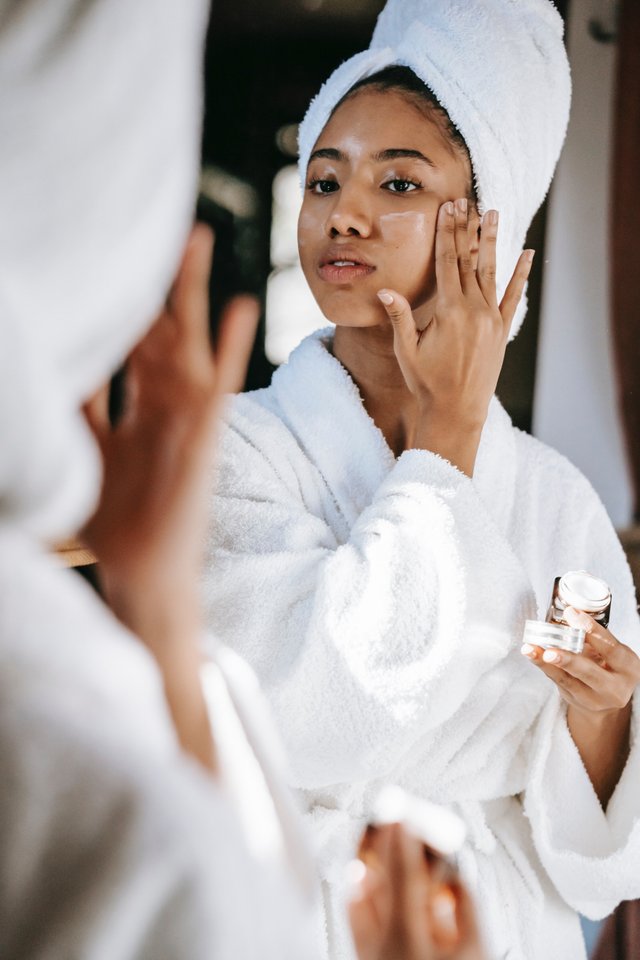Improve Your Skin’s Health With This Simple Skincare Routine
 Image Source: Sora Shimazaki for Pexels
Image Source: Sora Shimazaki for Pexels
Looking after your skin not only maintains its natural defence barrier and helps repair damage, it can also help to address any skin-related concerns or goals you may have.
And while everyone has different skin issues, there are basic steps common to every good skincare routine. This guide takes a closer look at each of these plus a range of tips and treatments for a healthier, happier skin.
Skincare techniques
A good skincare routine should be performed twice daily; once in the morning and again in the evening. And while the steps in each routine are similar, there are some important differences as well.
Morning skincare routine
Your morning skincare routine is about refreshing your skin and protecting it from the elements it will face throughout the day such as wind, UV and pollution. The steps involved should include:
- Cleanser – removes impurities such as oil or sweat that may have settled on your skin during the night and any treatments applied for dealing with specific skin issues. Washing your face helps avoid clogged pores and acne and is a crucial step in the skincare process.
- Toner – this is optional, but toner can help to exfoliate dead skin cells and tighten pores. It can also help to rehydrate skin after cleansing and prepare it for optimum absorption of any treatments to follow.
- Serum - serums contain ingredients for a range of skin issues. And even if you don’t have any particular concerns, applying a general anti-oxidant serum in the morning can protect your skin from daily aggressors such as pollution.
- Moisturiser – softens the skin and helps prevent water loss and should ideally be oil-free, fragrance-free and suitable for all skin types. The final step after moisturising is normally applying a sunscreen, but many moisturisers now include SPF 30+ sunscreen protection, so you can save time by combining the two steps.
Evening skincare routine
This is the time for your skin to repair itself and prepare for another day and the steps in your evening routine should include:
- Double cleansing - it’s important to cleanse at night, after your skin has been exposed to damaging elements during the day. Double cleansing involves cleaning the skin twice; firstly to remove any makeup or residues and the second time to deep-clean the skin.
- Serum – night serums target skin concerns overnight and your skin can benefit more at this time because your body goes into repair mode while you sleep.
- Moisturiser - moisturising in the evening helps to keep your skin nourished and hydrated overnight. Use a rich, creamy formula if you have dry skin and a lightweight gel formula if you have oily skin.
Common skin issues
Once you’ve established your skincare routine, you can start adding extra steps to address any skin concerns you may have. These might include:
- Acne – the use of a spot treatment containing ingredients such as benzoyl peroxide or salicylic acid can prove effective when applied before sleep.
- Dry or puffy eyes - applying eye cream helps the skin under your eyes remain firm and elastic and helps minimise fine lines.
- Dry, cracked lips - lip balm prevents flakiness and boosts hydration to minimise fine lines. Apply after moisturising and before applying makeup.
- Signs of ageing – treatments containing niacinamide (vitamin B3), peptides (amino acids) and retinoids (vitamin A) can help manage signs of ageing like sagging skin, fine lines and wrinkles.
- Dark spots - dark or brown spotting on the face can be treated with serums containing ingredients such as vitamin C and hydroquinone.
- Sun damage – as well as skin cancers, the sun’s rays can cause dark spots, wrinkles and other signs of ageing. Using an SPF 30+ sunscreen every day will provide protection against harsh UV rays.
- Dull lifeless skin – ageing causes a build-up of dead skin cells, creating rough, dry skin, enlarged pores and poor light reflection. Applying an exfoliating treatment removes this build-up, stimulating cell turnover and creating more smooth and translucent skin.
Skincare tips
And finally, a few things to bear in mind with your new skincare routine:
- If your routine isn’t producing immediate results, give your skin a chance to get used to the products you are using. Persevere for at least six weeks before switching.
Always apply skincare products in order of texture from thinnest to thickest (i.e. cleanser, toner, serum, moisturiser). - If you’re acne-prone, avoid thick makeup, sunscreen or lotions that can clog your pores. Look for products with “non-comedogenic” wording on the packaging.
- Use products with minimal ingredients, as the fewer there are, the easier it is to determine if they will cause a reaction.
- Look for sunscreens that contain a combination of physical and chemical blocking components, as they will protect from both UVA and UVB rays.
- Patch test any new product on your inner arm for a day or so before applying to your face in case you experience a reaction.
- Keep it simple. Start with a simple daily skincare routine and then expand it with additional steps as you see fit.